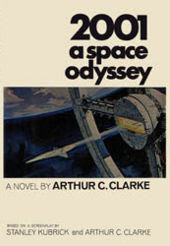If there are 2 things that Arthur C Clarke will be most famous for, my guess would be for his visionary work, including the concept of a geo-stationary satellite (most famously used to position communications satellites) and for his creation of the best seller 2001: A space Odyssey and its sequels (2010, 2061, and 3001). These were created for and along with an incredible movie of the same name by Stanley Kubrick. Together, this book, and the novel both captured the fascination with space (and its dangers), along with a fear of what an advanced computer (H.A.L) can do (somewhat similar to the fear of sharks that got positively entrenched with the movie Jaws).
Both the book and the screenplay for the movie went hand in hand, and were based on the short story 'The Sentinel' written by Arthur C Clarke in 1950. The novel was an important milestone in the history of science fiction, combining elements of man's historical development, delves into development of space travel and the problems of differential gravity, aliens and the thought that there is a master race that kick-started human development, and then how mankind may not have worked out all the issues related to intelligent computers.
The book starts from an age long long ago (3 million years ago) when there were humanoid races in Africa. They managed to survive, only just, getting fruits and the like, and not knowing how to hunt. They had short life spans, and did not have either the feelings of attachment to each other, and would not have been able to do much either. They were at the mercy of wild beasts, with no instruments with which to defend themselves. And then arrives a rectangular black monolith that starts to delve into their minds, developing their minds. They learn how to develop tools from the natural materials at hand such as rocks and the sharp teeth of wild animals. And then they develop the thought of being able to even fight back against the wild animals that threaten them; and most important, get meat from the wild beasts roaming around them. Humanity gets kick-started, getting into a period of development that leads to us.
Cut to the present age. Humanity has started exploration on the moon, and there they discover something that astounds them. A sheer black monolith has been discovered underground in the moon, in a sector that the US controls, and the eminent Dr. Heywood Floyd is sent to the moon to do further investigations and help the scientists over there. He is told that they have discovered a magnetic disturbance in a site now called Tycho Magnetic Anomaly-One (TMA-1), and they discovered the monolith underground. It is clear that this is not a natural creation, and was actually created 3 million years ago, so this has to be aliens.
Soon, the lunar sunlight hits them, and the monolith, exposed to sunlight for the first time in 3 million years, sends a strong radio signal out that reaches the far extent of the solar system. Switch to the next episode in the book. A ship Discovery One carrying 5 astronauts and an advanced computer HAL 9000 is on its way to Saturn on an exploration mission. 3 of those astronauts are in a state of hibernation, and the remaining 2, Frank Poole and David Bowman, are the ones who are the ones who are supposed to be in charge of the ship (or more likely, be secondary advisors to HAL who can run the ship totally on its own).
The HAL 9000 is an advanced computer, but its designers had never thought about wondering about the impact of the orders it had been given to the intelligent brain. HAL had been given orders to conceal the real knowledge about its mission to both Poole and Bowman (to explore Japetus, the 3rd largest moon of Saturn, the destination of the radio signal from the monolith on the moon), and this was conflicting with its other orders to report all the information fully. This was causing a conflict, and in these strained times, when it felt threatened with termination, it actually decides to kill the astronauts.
So, first it kills Poole by reporting one of the critical AE35 units as malfunctioning twice, and then when Poole goes to investigate, killing him with his own space pod. Then when Bowman threatens it with shut-down, it opens the airlock of the spacecraft to the pressure of the vacuum. Eventually, Bowman gets to an emergency shelter, and then retakes control of the spacecraft by shutting down the circuits of the HAl 9000 computer. He also buries the 3 hibernating astronauts in space, and decides to complete the mission on his own control.
He reaches Japetus with a lot of help from mission control, and discovers a black monolith on the surface. While reporting all this to mission control, he decides to approach Japetus using his space pod, and when almost there, before the pod reaches the monolith, he sends out a final signal 'The thing's hollow — it goes on forever — and — oh my God! — it's full of stars!'
Bowman goes through an extra-ordinary journey, realizing that the monolith is a giant switching system, similar to a 'Grand Central Station' of the universe. He sees things that he never thought that he would see, while in a protective shield that saves him from the surrounding regions (including a very close red sun). As he finally sleeps, his mind and memories are drained from his body, becoming a new immortal entity that can travel through space, a Star Child. Bowman now returns to the Solar System and Earth, and is now a very powerful entity, but unsure of what to do - something that he will eventually figure out.
Year in Review 2017
7 years ago
No comments:
Post a Comment